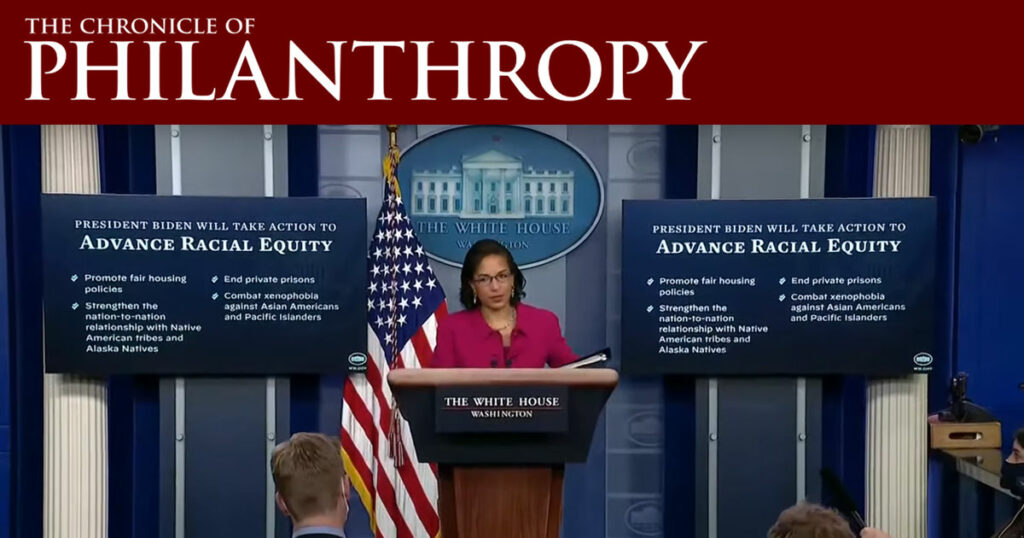News
Foundation Leaders Should Use Their Cash and Connections to Advocate for a Federal Racial-Equity Stimulus

Originally published in The Chronicle of Philanthropy.
With the stroke of a pen less than a week after his inauguration, President Biden did something no amount of philanthropic dollars could accomplish. He signed four executive orders to combat racial inequity. In quick succession, these measures strengthened anti-discrimination housing policies, ceased new federal contracts with private prisons, increased tribal sovereignty, and initiated government efforts to fight xenophobia against Asian Americans and Pacific Islanders.
These were just first steps toward the administration’s larger efforts to promote racial justice in the United States, but they should send a signal to philanthropy: All the increased giving to address systemic racism, as welcome as it is, can never substitute for the power and purse strings of the federal government. Nor should it.
Instead, philanthropic leaders should heed the words of President Franklin Roosevelt when a prominent labor and civil-rights activist urged him to take bold action against the Depression-era economy: “Go out and make me do it.”
At the same time, as philanthropy increases its own investments in racial equity, it can use its influence to insist on the bold solutions and government spending needed to close deep racial disparities in wealth, health, and education and put an end to discriminatory policies and practices in our criminal-justice system.
That bold action should stop at nothing short of a major federal racial-equity stimulus package.
Historically, when our nation has faced challenges so severe that normal self-correction was nearly impossible, policy makers have infused cash into the economy to stave off financial hardship and alleviate American suffering.
A little over a decade ago, the more than $800 billion American Recovery and Reinvestment Act helped pull the country out of the worst economic crisis since the Depression. The Biden administration’s $1.9 trillion coronavirus relief package, if passed by Congress, will bring total federal pandemic stimulus spending to nearly $5 trillion in less than a year.
‘More Difficult Than Rocket Science’
Eliminating 400 years of systemic racism certainly deserves a targeted economic stimulus of its own. Achieving such massive change requires a significantly greater level of resources than philanthropy has at its disposal. During the Clinton administration, where I worked as a senior policy adviser in the Education Department’s Office of Civil Rights, my colleague Chris Edley, then the administration’s senior counsel, often reminded me that “addressing racism is not rocket science. It’s more difficult than rocket science.”
Here’s a small snapshot of the problem: My organization, the Schott Foundation, through its annual Loving Cities Index, recently assessed how 20 cities are doing in providing the essentials for children and families to thrive, including access to healthy food, early-childhood education, affordable housing, and livable wages. Not one of those cities had more than 55 percent of the support needed for the healthy development of Black and brown children.
Findings like these should inform a racial-equity stimulus package, providing Congress and the White House with a potentially bipartisan framework to meaningfully address disparities at the local, state, and federal levels.
The Brookings Institution estimates the total racial wealth gap in the United States is $10.14 trillion, so that number can provide a starting point for what is needed. A multiyear, $10 trillion racial-equity stimulus package would give states, cities, and rural and tribal communities the resources to change the lives of historically undersupported American children and families.
Is it economically doable? Consider this: The U.S. economy is roughly $22 trillion. Thus, strategically investing $10 trillion over the next five years would mean an annual fiscal shot of less than 10 percent of total economic activity over that period.
The investment would indeed increase the nation’s debt but during a time when interest rates are lower than the expected rate of inflation. Simply stated, the federal government can borrow money for free, and should. As Treasury Secretary and former Federal Reserve Chair Janet Yellen stated: “Right now, with interest rates at historic lows, the smartest thing we can do is act big … I believe the benefits will far outweigh the costs, especially if we care about helping people who have been struggling for a very long time.”
The stimulus package should be designed to kickstart progress where disparities are most pronounced. Specifically, philanthropic leaders should urge policy makers to stimulate our economic, justice, education, and health systems in the following critical ways:
- Create equitable learning opportunities. Significantly increase investments in all children from birth through grade 12, including equitably funding schools serving low-income kids and supporting robust efforts to address lower graduation and college-enrollment rates among students of color. Historically Black colleges and universities and other institutions that primarily serve students of color should also receive much more funding, and free community college should be available for all who want it.
- Close wealth gaps. Sharply expand efforts to increase homeownership rates and investments in small businesses to benefit Black and brown families, We also need support for Black-owned banks and other financial institutions that more often serve people of color. We can no longer tolerate the long-standing wealth inequalities that have left white households with 11 times greater median wealth than Black households and six times greater wealth than Latino households.
- Reduce criminal-justice disparities. Invest in state and local job training and placement programs that address the lack of youth employment and post-incarceration job opportunities that lead to higher incarceration and recidivism rates. Support judicial-system reforms that take on discriminatory policing practices that harm people of color and lead to mass incarceration as well as prohibitive bail levels that criminalize poverty. Increase funding of community infrastructure projects such as health centers and public transportation that primarily help marginalized families and grassroots organizations that provide the social supports and civic engagement necessary for communities to thrive.
- Promote well-being of all of America’s families and children. Guarantee access to health care, eliminate education debt, invest in family leave, provide targeted tax credits to low-income families, and explore universal basic-income opportunities.
The United States has relied on similar fiscal packages for everything except the existential crisis resulting from centuries of systemic racism. This is the right time to take this step.
Is it politically doable? Realizing any vision requires leadership, and that’s where philanthropy can step up to meet this challenge — by using not only our cash but our influence.
Foundation presidents and boards can speak out publicly on the need for major economic stimulus funding that aims to close persistent racial-equity disparities.
Over the next 18 to 24 months, philanthropy can use its access to President Biden and members of his administration to push for this overarching goal.
At the same time, philanthropy should continue to increase support to grassroots and national racial-justice organizations that are building public and political will for this high-impact approach.
We’re at an inflection point in history. With greater public awareness of the economic as well as human costs of systemic racism, now is the time for philanthropy to act boldly.
As foundation leaders, we have the opportunity to build on the investments of private donor dollars to yield much larger public investments. We can make a difference by joining national and local advocacy partners in calling on the U.S. government to finally use its financial power to address the nation’s centuries-long plague of racial disparities.
The ability for foundations to use our investments in this way is philanthropy’s best business model for transformative systemic change.



